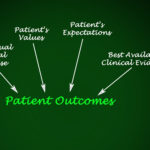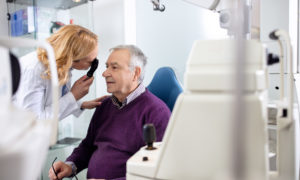By James E. Grue, OD,
and Ronald P. Snyder, OD, FAAO

July 1, 2020
Optometrists may not be taking advantage of all of their opportunities to maximize insurance reimbursements. Here is what you will be missing, and how you can start capturing those additional dollars.
Why Aren’t ODs Receiving “Alternate Payments?”
Many medical providers are receiving alternate payments which, in many cases, is significantly increasing their incomes. Why aren’t eyecare providers also getting alternate payments? Alternate payments, which are paid by Medicare and other payers, are not the same as the MIPS incentive payments, and have nothing to do with whether or not you participate in the MIPS program.
These alternate payments are separate reimbursements made to providers who demonstrate improved clinical outcomes that create potential savings for payers. They are not initiated by payers, but rather by providers that have taken the initiative to demonstrate improved outcomes.
The 21st Century Cures Act, which will be discussed in our next article, is providing the new rules for how clinical outcomes will be implemented throughout all of medicine. Information blocking will be eliminated, which will lead to extensive expansion of clinical outcome analytics. Just as the outcomes in the pandemic are driving the most important decisions, payers are increasingly using clinical outcome measures to decide which providers they want on their provider panels and how each will be paid.
Fee-for-service payments will not go away for eyecare in the near future, but any increases in reimbursements will occur as alternate payments similar to the way primary care physicians receive payments for getting better diabetic outcomes.
Focus More on Outcomes than Process
To understand how to successfully compete in this new environment, you simply need to look back at the past. As optometrists, we were taught to practice a “process” oriented approach to care. We were paid for doing tests that were based on simply following processes.

To learn more: 844.393.3282. (toll free) or ContactUs@HealthCareRegistries.com
For example, if you examined a diabetic patient, you would get paid for the exam and any ancillary tests. Everything that you got paid for was the result of following a set of processes. There was no consideration of the clinical outcomes that occurred from the result of the care that you delivered. The transition that is occurring in medicine is shifting emphasis from the process dominating the reimbursements and delivery of care, to understanding that the measure of the actual clinical outcome is much more important in guiding high-quality care delivery.
The prescribing of nutraceuticals for AMD is a process. The clinical outcome is the percentage of patients with AMD who convert from a dry to a wet maculopathy. If you send a letter to a PCP following a diabetic eye exam, this is a process measure. Working with the patient to help them reduce the risk of developing diabetic retinopathy, tracking the resulting change in their HbA1c and tracking what percentage of patients develop retinopathy are outcome measures. Moving from fee-for-service means we are moving from assuming that the processes we did resulted in improved care, to measuring the improvement that occurred.
Other Articles to Explore
Alternate payments provide a mechanism that allows payers to financially reward providers who demonstrate improved outcomes. Think of it as shared risk. Those providers who are not delivering outcome-based care, results in the payers taking all the risk. Providers who measure outcomes and share the risk with payers, gives payers the ability to reimburse providers at a higher rate.
Let’s look at how we manage the eyecare for diabetes as an example to better understand this point. With the fee-for-service reimbursement approach, most eyecare providers would do an exam focused on determining whether or not diabetic retinopathy was present. If present, typically the provider would refer the patient to a retinal specialist or have the patient return for appropriate follow-up visits to monitor the condition until a referral was needed.
If your exam reveals no retinopathy, most eyecare providers would tell the patient there is no retinopathy, explain what retinopathy looks like and why the patient needs to be followed to see if it develops, and schedule the patient for a follow up exam. Traditionally eyecare providers have not taken any responsibility or worked with their patients to help them reduce the risk of developing retinopathy.
Why would a payer pay a premium for this type of care? In this type of care model, every provider would be expected to do all of these steps. What would a payer even base an alternate payment on?
Contrast that process to outcome-based care where the provider follows the new AOA guidelines and takes on the additional role of managing the diabetic patient to help reduce their risk of developing retinopathy. This is the most important role that optometry can play in the management of a diabetic patient. Optometrists, who follow the AOA guidelines, are positioned to be recognized for lowering the HbA1c, in some cases, from 11 or higher to potentially below 7.
Algorithms exist that show the savings to a payer for each point the HbA1c is reduced. Providers that can demonstrate that they are helping the patient lower their HbA1c, can now provide payers with data that directly converts to a savings for the payer. The amount of savings is the basis that the payer uses to determine the amount of the alternate payment. In simple terms, it is risk sharing.
When a provider delivers care that is not associated with reducing the risk, such as the care typically delivered under fee-for-service, then the payer has nothing on which to base alternate payments and takes all the risk. When an eyecare provider tracks the change in the HbA1c over time demonstrating reduced risk of developing retinopathy, and can also eventually show a reduced incidence of diabetic retinopathy as a result, the payer can then calculate the savings and put in place alternate payments to encourage the provider to make the effort to continue to deliver that kind of care. In this model, the provider collects the regular fee-for-service fee and gets an additional alternate payment based on the level of improved outcomes.
Substantial Reimbursements Are at Stake
It is important to understand that the amount of the reimbursements is not insignificant. The new Evidence-Based AOA Clinical Guidelines for the Management of Diabetes cites a study indicating that if the HbA1c is reduced from an average of 9 to 7 over a 10-year time period, the amount of retinopathy is reduced by over 50 percent in most patients and as much as 76 percent in some patients.
Those numbers are impressive, but understand that when you, as an eyecare provider, help the patient lower the HbA1c for the purpose of reducing their risk of developing diabetic retinopathy, it is also reducing the risk of developing all other diabetic complications. If eyecare providers nationally were delivering this type of care, the annual cost of managing diabetes would be reduced by billions of dollars. The savings to payers would create the basis for alternate payments to eyecare provides.
You are likely thinking, how can an eyecare provider help the patient reduce their risk of developing diabetic retinopathy? The only thing a physician can do that you cannot do as an eyecare provider is to prescribe the diabetic medications. Oral medications only lower the HbA1c on an average of 1.5 – 1.8 points. Everything else is done by working as a team which includes the patient, PCP, possibly a care coordinator, a diabetic educator, a nutritionist, maybe an endocrinologist, a dietician and other specialists.
You can not only be a valuable part of the patient’s care team; there is growing outcome-based evidence that eyecare providers may be the most effective members of the team in helping the patient get better control of their condition. Because of the limits of the scope of an optometric license, ODs cannot treat diabetes, but the new evidence-based AOA Guidelines for the management of diabetes make it clear that it is the responsibility of the optometrist to help the patient understand what they can do to reduce the risk of developing retinopathy. You can fulfill this role without ever mentioning anything about treating diabetes or doing anything that is not clearly allowed under your optometric license.
The other question you may be asking is how you will have the time to provide this level of care. As an active member of the patient’s care team, you will be taking advantage of features that are already built into your certified EHR, that will allow you to see more patients, and deliver outcome based care, in a shorter time than you are currently spending with patients. The clinical outcome measures are all done in the background and take no additional time for either the providers or the staff.
It is up to us, as providers, to decide whether to continue down the path of simply being happy accepting fee-for-service payments, or move to outcome-based care as the rest of medicine is doing, and enjoying the financial rewards associated with alternate payments. There are existing organizations that have programs to guide you through every step of transitioning to outcome-based care and outcome registries to track the clinical outcomes.
 James E. Grue, OD, is a health-care reform speaker and consultant. To contact him: JimGrue@HealthCareRegistries.com
James E. Grue, OD, is a health-care reform speaker and consultant. To contact him: JimGrue@HealthCareRegistries.com
 Ronald P. Snyder, OD, FAAO, is the president and CEO of HealthCare Registries, LLC. To contact him: RonSnyder@HealthCareRegistries.com
Ronald P. Snyder, OD, FAAO, is the president and CEO of HealthCare Registries, LLC. To contact him: RonSnyder@HealthCareRegistries.com



























